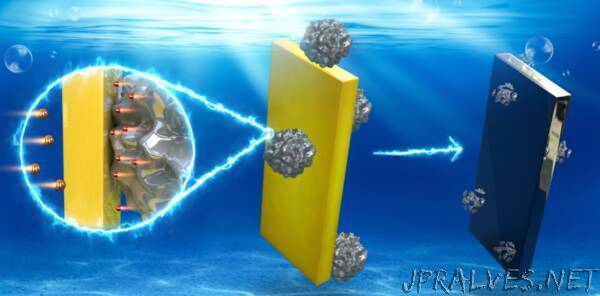
“In a study published in Advanced Materials, the researchers from Hefei National Laboratory for Physical Sciences at the Microscale, the University of Science and Technology of China of the Chinese Academy of Sciences, using an electron–proton co-doping strategy, invented a new metal-like semiconductor material with excellent plasmonic resonance performance. This material achieves a metal-like ultrahigh free-carrier concentration that leads to strong and tunable plasmonic field.
Plasmonic materials are widely used in the fields including microscopy, sensing, optical computing and photovoltaics. Most common plasmonic materials are gold and silver. Some other materials also show metal-like optical properties but just perform poor in limited wavelength ranges.
In recent years, much effort has been made in finding high-performance plasmonic materials excluding noble metals. Metal-oxide semiconductor materials have rich and tunable properties such as light, electricity, heat, and magnetism. Hydrogenation treatment can effectively modify their electronic structure to reach rich and tunable plasmon effects. It is a challenge to significantly increase the intrinsically low concentration of free carriers in metal-oxide materials.
The researchers in this study developed an electron–proton co-doping strategy with theoretical calculations. They hydrogenated the semiconductor material MoO3 via a simplified metal–acid treatment at mild conditions, realizing the controllable insulator-to-metal phase transition, which significantly increase the concentration of free carriers in the metal-oxide material.
The free electron concentration in the hydrogenated MoO3 material is equivalent to that of the precious metal. This property makes the plasmon resonance response of the material moving from the near infrared area to the visible light area. The plasmon resonance response of the material has both strong gain and adjustability.
Using ultrafast spectroscopy characterizations and first-principle simulations, the researchers unraveled the quasi-metallic energy band structure in the hydrogen-doped HxMoO3 with its dynamical features of plasmonic responses.
To verify their modification, they performed the surface-enhanced Raman spectra (SERS) of rhodamine 6G molecules on the material. The result showed that the SERS enhancement factor reached as high as 1.1 × 107 with a detection limit at concentration as low as 1 × 10-9 mol/L.
This study developed a general strategy to increase the concentration of free carriers in a non-metal semiconductor material system, which not only realized a quasi-metallic phase material with strong and tunable plasmon effect at low cost, but also significantly broadened the variable range of the physical and chemical properties of semiconductor materials. It provides a unique idea and guidance for designing novel metal oxide functional materials.”
